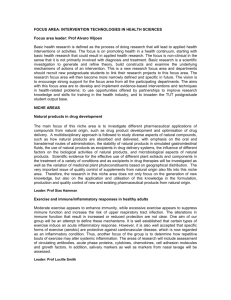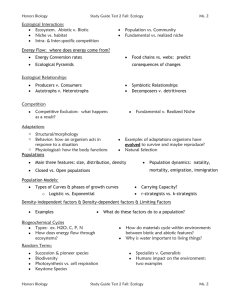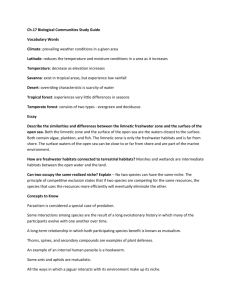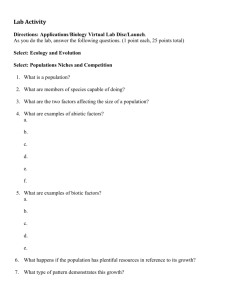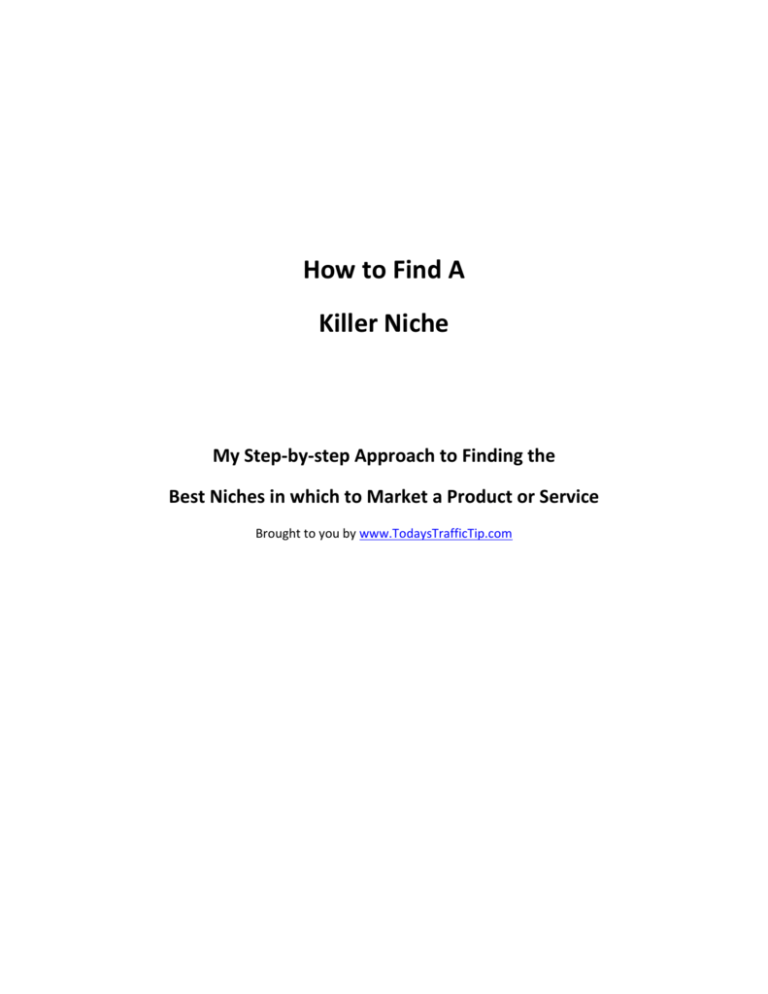
How to Find A Killer Niche My Step‐by‐step Approach to Finding the Best Niches in which to Market a Product or Service Brought to you by www.TodaysTrafficTip.com How to Find a Killer Niche Copyright 2008 Street Muse Publishing
ALL RIGHTS RESERVED. No part of this report may be reproduced or transmitted in any
form whatsoever, electronic, or mechanical, including photocopying, recording, or by any
informational storage or retrieval system without express written, dated and signed
permission from the author.
DISCLAIMER AND/OR LEGAL NOTICES:
The information presented herein represents the view of the author as of the date of
publication. Because of the rate with which conditions change, the author reserves the right to
alter and update his opinion based on the new conditions. The report is for informational
purposes only. While every attempt has been made to verify the information provided in this
report, neither the author nor his affiliates/partners assume any responsibility for errors,
inaccuracies or omissions. Any slights of people or organizations are unintentional. If advice
concerning legal or related matters is needed, the services of a fully qualified professional
should be sought. This report is not intended for use as a source of legal or accounting advice.
You should be aware of any laws which govern business transactions or other business
practices in your country and state. Any reference to any person or business whether living or
dead is purely coincidental.
© 2008 Street Muse Publishing
Page 2
How to Find a Killer Niche Selecting A Niche Market When selling a product, a lot of people make the mistake of developing their product first, and then trying to find a market for it. The process should really be reversed. Find a market first that spends money, then find out what they want and give it to them. It is certainly easier said than done, but there are a lot of places online where you can do your market research for free. They've done most of the work for you already. You just need to know where to go and what to do to connect all the dots. When you think you’ve found such a niche market, ask yourself these important questions: 1) Do you have an interest or passion for the niche? If not, do you think you can develop one? Or will you get bored with it quickly? 2) Are other people passionate about your niche? If not, do they have a desperate problem they want to solve? 3) Is the market big enough, but not so big you’ll have too much competition when you’re just starting out? 4) Do the people in this niche spend money? 5) What products are being successfully sold right now to this niche? Can you sell something similar? Can you improve it, give them something they want that all other products of their kind are currently lacking? 6) What are these existing products in your target niche being sold for? Could you be profitable selling a similarly priced item? Or are your potential competitors selling cheap on the front so they can upsell, cross sell, or make their money on the back‐end? What Are the Differences Between Upsell, Cross Sell, and a Back‐End Sale? Upsell: After they make their purchase (but before they pay), you attempt to upgrade them to a premium version of the offer for more money. (e.g. A fast food restaurant might ask them whether they’d like to “supersize” their order. A movie refreshment stand might as whether they’d like a large soda for only 75 cents more instead of a medium one) Cross sell: After they make their purchase (but before they pay), you attempt to sell them complementary products. (e.g. a Fast food restaurant might ask “do you want fries with that” when only © 2008 Street Muse Publishing
Page 3
How to Find a Killer Niche a sandwich is ordered) Back‐end sales: After they have purchased your product (and paid for it), you follow‐up with them at a later date and attempt to sell them a more expensive product that they may be interested in, usually, but not always, complementary to the original product they purchased (e.g. Someone purchases the soundtrack to the Sopranos from Amazon. When the Sopranos mega‐anniversary platinum entire DVD collection comes out, Amazon sends you an email to let you know about it and how you can get a discount if you buy from them) So Where Can You Get Ideas For A Niche Market To Explore? Brainstorming and Research Online Resources ‐ Offline •
Newspaper •
Niche magazines •
TV and radio •
Catalogs and mail order – subscribe to newsletters, purchase inexpensive products, get on mailing lists •
Tabloids and mainstream media •
Billboards and other advertising media – watch what other companies are doing offline in all their advertising media •
Talking to people – at your local watering hole, coffee shop, friends and neighbors, business partners, customers, relatives. Talk to them and OBSERVE. What are their hobbies, their interests, their problems? •
Books – A greatly underutilized idea‐generating machine! •
Grabbing a pad and pen and going to your favorite “quiet” spot to brainstorm Let me show you the process I go through when I'm trying to brainstorm for ideas. For starters, I'm always aware of trends and current events in the real world. I read several newspapers each day, many magazines, both general and niche‐specific, I watch the news, I listen to the radio. Occasionally something that I hear or read will stick with me. I may record my thoughts on my portable voice recorder, jot down some notes, whatever happens to be convenient for me. Sometimes I'll call my office voice mail and leave myself a message. © 2008 Street Muse Publishing
Page 4
How to Find a Killer Niche But at some point I'll have several broad ideas to research. I want to look deeper. And I want to make sure there is a good market for them before I even think about creating a product. So I'll begin completing the following steps: Google Zeitgeist ‐ http://www.google.com/press/zeitgeist.html To begin with, I check out the hottest search trends at Google Zeitgeist. From here I can select: •
Google Trends ‐ For a broad look at search query data, enter up to five search terms to see relative popularity over time. •
Trends for Websites ‐ Google Trends for website traffic data. Type in a website address to see visitors by region and related sites visited. •
Insights for Search ‐ A deeper dive into search query data for marketers and power users. Create your own lists of "most popular" and "fastest rising" queries for different geographic regions over time and by topic. •
Hot Trends ‐ The top 100 fastest‐rising search queries right now (U.S. only). Updates throughout the day. I can also click on “Year‐End Zeitgeist” or “Zeitgeist Archives” in the upper‐left corner to look at past trends, especially if I’m researching cyclical or other trends over time. At this point I am just looking for ideas. If I see that a particular topic is hot, I’ll make a note of it and look at more targeted sub‐niches later on at more specialized sites (which I’ll show you shortly). © 2008 Street Muse Publishing
Page 5
How to Find a Killer Niche Lycos Top 50 ‐ http://50.lycos.com The Lycos Top 50 is another site, like Google Zeitgeist, where I will review the latest trends and look for hot topics to explore further. I will also look at Yahoo! Buzz for ideas as well (see below). Yahoo! Buzz ‐ http://buzz.yahoo.com eBay Pulse – http://pulse.ebay.com The eBay Pulse site is a great place to start looking at sub‐niches. What I will do is select the category first (using the topics I’ve gathered from looking at the previous sites), then look for profitable sub‐
niches by then selecting a sub‐category. The best chance for success is if I am as specific as possible with my niche selection. In the example below, I don’t want to sell to the “crafts” niche. I want to sell to grandmothers who enjoy giving their latch rug hooking gifts to their families and friends. Whatever. You get the idea. Also, I’ll always check the largest stores as well to see what they’re selling. There has to be a reason they are the largest stores. They must be doing something right. Now that I have some potential sub‐niches to work with, I want to see how much of a market there is there. Just because a sub‐niche is popular doesn’t mean people spend money on it. Amazon ‐ http://www.amazon.com Amazon is a great place to see what currently exists for any given sub‐niche. Chances are, the more books there are written on that subject, the more that market spends on those topics. © 2008 Street Muse Publishing
Page 6
How to Find a Killer Niche Next I may use certain qualifying keywords to discover potential niches. You may have heard these called “discovery keywords”, and they are exactly that. If you go to Google and type in any of the following keywords (make sure you surround them with double quotes for exact matches): •
•
•
•
•
•
•
•
•
•
•
•
•
•
•
•
•
•
•
•
•
•
•
•
•
•
•
•
•
•
•
•
•
•
•
•
•
•
•
How to How do I How do you How to fix How do I fix How do you fix How to prevent How do I prevent How do you prevent How to cure How do I cure How do you cure How to remove How do I remove How do you remove How to quit How do I quit How do you quit How to get rid of How do I get rid of How do you get rid of How to lose How do I lose How do you lose How to get How do I get How do you get How to stop How do I stop How do you stop learn get rid of fix remove prevent cure quit lose get © 2008 Street Muse Publishing
Page 7
How to Find a Killer Niche •
•
•
eliminate restore stop You can also use the Google Keywords Tool (https://adwords.google.com/select/KeywordToolExternal), just make sure you uncheck “Use Synonyms”. You only want exact matches. Discovery keywords are a great way to find what people are looking to do, solve, or accomplish. Finally, I like to capitalize on the “low hanging fruit.” That is, it’s always much easier to sell a similar product to one that’s already selling well than to try to enter a market cold. If you research your potential competitors up front, you’re going to get a pretty good idea as to how well they’re doing, both in terms of checking their traffic rankings by Alexa (http://www.alexa.com) and Compete.com (http://www.compete.com), as well as their Pay‐Per‐Click (PPC) ads in Google, Yahoo, and MSN (at a minimum). We’re going to cover that in the next section. For now, let’s recap on some of the resources we’ve discussed, plus add a few more. Then I’ll show you how to research your niche, a very important part of the process. After that, I’ll show you a quick way to check the potential profitability of a niche. © 2008 Street Muse Publishing
Page 8
How to Find a Killer Niche Brainstorming and Research Online Resources‐ Online •
Google Zeitgeist ‐ http://www.google.com/press/zeitgeist.html •
Trend Watching ‐ http://www.trendwatching.com •
Trend Hunter ‐ http://www.trendhunter.com •
Online news websites – cnn.com, foxnews.com, cnbc.com, and local stations •
Lycos Top 50 ‐ http://50.lycos.com •
Yahoo! Buzz ‐ http://buzz.yahoo.com •
eBay Pulse – http://pulse.ebay.com •
Amazon ‐ http://www.amazon.com •
Google Trends ‐ http://www.google.com/trends •
Shopping.com Top Searches ‐ http://www10.shopping.com/top_searches •
AOL Hot Searches ‐ http://hotsearches.aol.com •
Google Groups ‐ http://groups.google.com •
Craig's List ‐ http://www.craigslist.com •
Delicious Popular ‐ http://del.icio.us/popular •
Dig ‐ http://www.digg.com •
Google Catalogs ‐ http://catalogs.google.com •
Magazines.com ‐ http://www.magazines.com •
Amazon ‐ http://www.amazon.com/exec/obidos/tg/browse/‐/599858/ •
Clickbank Marketplace ‐ http://marketplace.clickbank.net © 2008 Street Muse Publishing
Page 9
How to Find a Killer Niche Researching Your Niche This is an important stage, not to be skipped, because you want to find out if this niche will be profitable for you. Plus you are entering the beginning stages of product research as well. Remember, in this stage, you especially want to know… •
Are other people passionate about your niche? If not, do they have a desperate problem they want to solve? • Is the market big enough, but not so big you’ll have too much competition when you’re just starting out? • Do the people in this niche spend money? • What products are being successfully sold right now to this niche? Can you sell something similar? Can you improve it, give them something they want that all other products of their kind are currently lacking? Let’s run through the steps for this important strategy. Step 1 – Keyword research. Build a spreadsheet with the most common searched‐for terms for your niche. Start with some basic keywords (i.e. if you were in the crafts niche, you would start with the word “crafts” and branch out from there) Here are some good keyword tools to help you generate your starting list: • http://www.kwbrowse.com ‐ Good keyword visualization tool • http://freekeywords.wordtracker.com ‐ Free version of keyword tool Wordtracker • http://tools.seobook.com/keyword‐tools/seobook/ ‐ SeoTools, powered by Wordtracker • http://www.goodkeywords.com ‐ Free Windows software for finding keywords • http://www.digitalpoint.com/tools/keywords/ ‐ Search engine keyword tracker & keyword ranking tool • http://www.nichebotclassic.com ‐ Still a great resource, also powered by Wordtracker • http://www.keyworddiscovery.com ‐ Paid or free trial • https://adwords.google.com/select/KeywordToolExternal ‐ Google’s free tool There are MANY more keyword research tools out there. With the demise of Overture’s free service, many of them are still out there, but provide outdated or useless information. These are a good bunch to start with. © 2008 Street Muse Publishing
Page 10
How to Find a Killer Niche A couple more useful resources: • http://www.terapeak.com ‐ Researches eBay auctions over the last 30 days • http://addictomatic.com ‐ Research site that scrapes the web for keywords you specify Step 2 – Discover your major competitors in this niche. Perform some Google searches for your main competitors and see who the advertisers are in the right‐hand panel (i.e. Google Adwords advertisers). Make a list of the top 10 competitors you will face (i.e. only those who sell similar products to what you are considering—for example, if you’re going to sell an info‐product, ignore the ones with physical goods). This is one gem for finding out if your market is hot. If companies are paying for advertising for similar products as yours, it’s a good indication they’re making money. If they weren’t, they could keep paying for ads. We’ll get into this in a little more detail, because there’s a better indicator I call my “magic window” that I’m going to reveal to you in a moment. Step 3 – Research the top discussion forums and communities for your niche. Do a search on Google for forums in your niche. For example, if your niche is freestyle Frisbee, you might so a search for “freestyle Frisbee forum” or “freestyle Frisbee discussion board” or “Frisbee discussion”. Forums are a GREAT way to find out what your market wants. Sign up as a member to these forums and start by “lurking”. That is, just spend some time reading all the posts. Then when you feel more at ease with the group, introduce yourself and start asking questions. Tell them you’re considering buying one of your competitor’s products. Get their feedback. Ask them what they like and don’t like about it, etc. Step 4 – What blogs do they read? Check out the top blogs in your target market by doing a search on: • http://www.technorati.com • http://www.blogcatalog.com Also check out the “blogrolls” at each of the blogs you visit and see who else they’re linking to. Make a list of the top 10 to 20 blogs or so here: Step 5 – Check out YouTube.com and Google Video (http://video.google.com) and do a search for your keywords. See what videos come up. Are they marketing‐related? Do they include a website address on it to learn more, where they’re selling a product or service? Step 6 – Do a search on Google, Yahoo, and MSN and see who has the top rankings for your keywords © 2008 Street Muse Publishing
Page 11
How to Find a Killer Niche Step 7 – Other miscellaneous research. Search PRWeb.com and look for any press releases related to your market. Search EzineArticles.com and save the articles that are related to your market. Use Alexa.com and Compete.com to see which of your potential competitors are getting the most traffic. Search Google using your keywords and add “+ezine” or “+newsletter” at the end to find email newsletters. Step 8 – Search clickbank.com and cj.com to see what products in your market are being sold and for how much. © 2008 Street Muse Publishing
Page 12
How to Find a Killer Niche A Quick Way To Check The Potential Profitability Of A Niche I mentioned above that Amazon was a great place to do research. Amazon ‐ http://www.amazon.com It's also a great place to see what currently exists for any given sub‐niche. Chances are, the more books there are written on that subject, the more that market spends on those topics. For example: First I specify “Books” to search. Then I enter my niche, in this case “crafts.” As you can in the screen snapshot above, there are WAY too many books returned. This niche is not targeted enough. It is too "mainstream." © 2008 Street Muse Publishing
Page 13
How to Find a Killer Niche Much better! There are possibilities here. We now suspect the following: 1) This sub‐niche may be targeted enough. 2) This sub‐niche may spend money. Time to scope it out a little further. We want to be as certain as we possibly can that our niche is focused enough but big enough, and that the people in that niche spend money. So next I head over to Wordtracker (you can use the free version at http://freekeywords.wordtracker.com) and see how many estimated daily searches there are for our niche and related keywords. © 2008 Street Muse Publishing
Page 14
How to Find a Killer Niche I like to see at least 330 searches a day for all keywords combined, but not more than, say, 1700 or so (although I do have profitable niches that have only a hundred or so searches, but they are the exception rather than the rule). For “latch rug”, you can see that this market is just too small. You can see how Wordtracker calculates its estimated daily search volume here: http://freekeywords.wordtracker.com/estimate‐of‐daily‐search‐volume.html If I’m happy with the number of searches for this potential niche, I next want to see how much pay per clicks (PPC) are going to cost me on Google Adwords. For that I can use a tool like SpyFu (http://www.spyfu.com), which gives you some good intel for spying on your competitors. © 2008 Street Muse Publishing
Page 15
How to Find a Killer Niche Since we ruled out latch rugs, let's try "iphone". I want to make sure I won’t have to pay more than a dollar or two per click on average, but of course what you can profitably pay for PPC will depend on your product’s selling price and how many you can sell. Again, at this point I’m just trying to get a snapshot or pulse of this market. Plus, the bid process also tells you a little about the moneymaking opportunities of a market. As a loose rule, if the cost/click hits anywhere between 50 cents and $3.00, it’s a good indicator that people are making money in this market. I call this my “magic window.” Over $3.00 means that the competition is too fierce for my tastes, but depending on your market and eventual product selling price and demand, it may make sense for you. Another great tool I pointed out is Google Trends (http://www.google.com/trends). © 2008 Street Muse Publishing
Page 16
How to Find a Killer Niche There’s lots of useful information here. You can see that the news volume is synced with the search volume, and several notable news articles are displayed, along with where they occurred on the timeline. In the lower section, you can see which countries, cities, and languages made the most searches. Be aware that the indicators are normalized, meaning they are adjusted for that region’s population. For example, South Africa has about 44 million people, compared with the U.S.’s 295 million. So the U.S. may have performed more actual searches, but after the adjustment is made, South Africa comes on top for this search term, which is “fly fishing.” In the upper‐right corner of the page, you can switch regions (e.g. if you wanted to check the U.S. only), and you can change the time period. For example, notice below how I changed the time period to a single month. See any cyclic trends there? You may have noticed that searches for this topic tend to spike every Friday, going into the weekend, and then fall again during the week. This information may be useful if you are going to advertise with Google Adwords, and you’re launching a firesale or other limited time campaign, because you’ll want to schedule your campaign around one or more of those spikes. Some markets have different patterns, so it’s useful to be aware of them prior to launch. Another great use for Google Trends is if you are trying to decide between two different niches. If you enter your search terms and separate two or more with a comma, Google will compare them for you. © 2008 Street Muse Publishing
Page 17
How to Find a Killer Niche Very useful. The work is already done for you. You just need to put it to good use. As you can see above, piano is too broad a niche. It has a high amount of searches, but the bids for PPC traffic is too low. As a result, I would suspect that people are generally not making a lot of money with that search term. Remember, high volume + low PPC bids = low click through rates and even lower conversions. Fly fishing, on the other hand, does have PPC bids within my “magic window”, so money is likely being made there. However, the search term itself is too low. Unless you have other keywords for that niche to add additional traffic, I would steer clear from there as well. Remember, these aren't rules set in stone, but rather guidelines to give you more resources in your arsenal. Combine this strategy with some of the sites and methods in this guide, and you now have the ability to find out an awful lot about any niche, and any competitor in that niche. You'll also want to check the products for sale in your niche at www.clickbank.com (for digitally‐
delivered products) or www.cj.com (for physical products). A good site to see what the most popular products in Clickbank right now is http://cbtopsites.com/downloads/downloads Here's a GREAT site for gauging how big or small a niche is: http://lists.nextmark.com It allows you to search through 60,000 mailing lists to see how many subscribe to lists with your main niche keywords. Keyword Elite (www.keywordelite.com) is also a great tool for scoping the competition. © 2008 Street Muse Publishing
Page 18
How to Find a Killer Niche And let's not forget Google Alerts (http://www.google.com/alerts), a free service that lets you specify keywords, and whenever a new page pops up somewhere with those keywords, Google will notify you by email. There are MANY resources out there that'll help you with this kind of research. The key is to stick with the ones you find helpful and that are working for you. If you try to run your niche through every tool out there, you're going to get some conflicting results, and it's going to take you forever. Keep it simple. Find a good niche, and move on. Here's another site to help you find good niches: http://www.43things.com/zeitgeist/recently_popular_goals ‐ These are things people want to do. They're telling YOU. One other tool that may help you: http://www.mindmeister.com ‐ A free online mind mapping tool, for those that like to organize everything using mindmaps. Google Insights (http://www.google.com/insights/search/) is similar to Google Trends, but it gives some different information and flexibility. Still a very useful tool in determining market demand for your chosen keywords across time, major news stories that broke along the time line (like Google Trends) that could contribute to the niche's popularity, etc. And as I mentioned, I’ll always Google my keywords and check out the competition in the Adwords ads. In this case I pay special attention to the ads that sell information products (or services like mine if I’m selling a service). Some of the ads will be irrelevant as far as competition goes. Ok, the next thing I'll do is check how many magazines there are on the subject of my chosen niche. There are two places I go online for that: Magazines.com ‐ http://www.magazines.com and Amazon ‐ http://www.amazon.com/exec/obidos/tg/browse/‐/599858/ At each site, I search by category to find the magazines in my niche. Obviously the more the better, up to a point. For example, golf has a lot of magazines, but it's not a good niche by itself. It needs to be more targeted. But in that case I can always get more targeted sub‐
niche ideas within that topic by looking at the types of magazines for that topic. © 2008 Street Muse Publishing
Page 19
How to Find a Killer Niche Now, as good as these sites are for finding magazines, I'm still going to need to go to a bookstore that carries lots of magazines and browse through the ones in my niche? Why? Because I want to see what kinds of ads are in them. I need to know who else is selling what, and it will also tell me whether the people in this niche spend money. And the ads will not only tell me that, but they will also tell me what the people in this niche spend their money ON. And if I want to know which ads keep appearing (because then I'll know they are making money), I would want to pick up several issues in a row of the same magazine, if possible. Ok. By now I should have a pretty good niche market to test. And by knowing what kinds of informational products are selling, I can start to formulate the content I’m going to use for my test. This is where I go to niche‐specific sites. So I’ll set up a mini‐course on my autoresponder with my content. I like mini‐courses better than just a free report to get them to opt in, because the free report is a one shot deal. I want to “train” them to be on the lookout for my emails, to anticipate them and open them. That way when (or if) my offer shows up in their inbox, it may have only been a day or two since they last heard from me, not weeks or months ago when they got their free report (in that case they’ll likely forget they signed up for your list and promptly delete your offer, unsubscribe, or report it as spam). If I have a free report I want to use, I’ll simply break it up for my mini‐course. But as this is a new niche, it’s unlikely I’ll have a report yet. I’ll then set up some very targeted PPC ads using Adwords. I want to match each ad group to the keywords as closely as possible. Then I turn it all on and start building my list. So where’s the product, you ask? Well, at this point, I don’t know for certain how much traffic I’ll get or whether they’ll opt in or not, never mind whether they will purchase my product. I have an idea, due to my research. But now we want hard numbers to back it all up before I invest any more of my time and money. Hence, the testing. There are two things I primarily watch as the list begins to build: 1) How much traffic I am getting from PPC. I want to compare what I’m getting with my previous estimates. At this point I want real numbers, not estimates. 2) My opt in percentage. If it’s too low, either my squeeze page copy needs to be tweaked, or, if I’ve done my homework with my copy, perhaps this market is not made up of enough buyers. Listen, if they’re not going to opt in, they’re certainly not going to buy. Now if my traffic and opt‐ins are both good, now is the time to start thinking about a product, which ideally should be along the same lines as the content they signed up for in the first place. © 2008 Street Muse Publishing
Page 20
How to Find a Killer Niche Sometimes I will even email my list at this point and simply ask them what they want, or try to determine their wants and needs from carefully constructed survey questions. Just remember that people often say one thing and do another. It’s only 100% accurate when they vote with their wallets. An even better way to test your list’s desire for a particular piece of information is to announce a free teleseminar to them, then see how many show up. If a large percentage of your list calls in, it’s a good bet they’re interested in your call topic. HINT: Teleseminars also make GREAT products or bonuses themselves if you record them and sell them after the fact. In fact, sometimes I’ll announce a paid teleseminar rather than a free one. Why? Because then I know people will pay money for that information, an even better test indicator. They are voting with their wallets. Plus I can always sell the call recording after the fact as well. Another technique to test whether this niche is built up of buyers or tire‐kickers and freebie seekers is to promote an affiliate product within that niche. If the product content is similar in nature to what you want to create as your product, it’s a good indication that you have the potential to get a similar percentage to buy yours. Just make sure it’s either a non‐competing product or a front‐end sale. If it’s a front‐end sale, you’ll develop a mid or back‐end product. Bear in mind that in the case of the latter, you’ll get less of a percentage to buy (compared with the percentage who bought your affiliate front‐
end product), but you may make up the difference and then some with a higher ticket item. It’s a risk, but it should be a calculated one. The beautiful thing is, once I confirm a niche will be profitable, with this approach I already have a pre‐
built list that keeps getting bigger by the time I launch the product. So there you have it. There are plenty of sites I use for research in addition to the ones above, but they are usually niche specific. These sites will help you to research practically any niche market effectively. Once you have this process down, you’ll be able to do this very quickly. After all time is money. © 2008 Street Muse Publishing
Page 21




